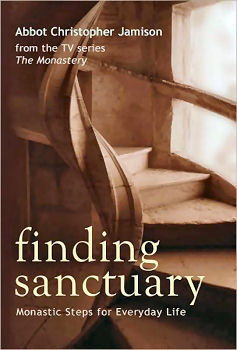
|
Posted May 25, 2010
Book: Finding Sanctuary: Monastic Steps for Everyday Life Author: Abbot Christopher Jamison Liturgical Press. St. Cloud, MN. 2006. Pp. 182 An Excerpt from the Jacket:
The TV series The Monastery involved five very modern men living the monastic life for forty days and forty nights while TV cameras tracked their progress. The sight of monks responding thoughtfully and helpfully to ordinary people’s struggles was a surprise to millions of viewers who had presumed that monks were out of touch. St. Benedict wrote his Rule for monastic living 1,500 years ago. It is a book of insights about Christian living, with suggestions about how to put those insights into practice. The insights in the Rule are still guiding people today, and they are the foundation of the sancturaries that are the Benedictine monasteries and convents of the 21st Century. In Finding Sanctuary, Abbot Christopher outlines the wisdom of St. Benedict and suggests how it can be applied to people outside the monastery. He speaks especially to those who are not sure what they believe but are looking for ways to find spiritual space and peace in the busy and often confusing, modern world. An Excerpt from the Book: Good Conversation in Practice Whether helping people to deal with marital breakdown or with conflicts at work, I find that the need for good conversation is as relevant as ever in sustaining people in their communities. The busyness of their lives can lead people to neglect speaking directly to spouses or colleagues about serious matters; the superficial is always easier to talk about. People find it particularly hard to express their feelings about what is happening, and it is important to create a safe space within which people can express themselves. When I was working as the headmaster of our school, our management-team meetings ended with five minutes during which each person was asked to say what they had been feeling during the meeting. There was no discussion, just a series of statements by the participants; the convention was that you had to express your feelings about the meeting there and then, not behind people’s backs. “I was annoyed when you cut across me” . . . “I really appreciated the way the group helped me to clarify that proposal” . . . “I was depressed by that financial report.” These are examples of what people said, and it helped to ensure a deep sense of working together as complete human beings, saying the hard things if necessary and then moving on. Good conversation requires not only good speaking but good listening. So in fact “restraint of speech” (the title of Benedict’s chapter on silence) is the essential corollary of good speaking, not its opposite. This is real community living and it is essential if human beings are to be their best selves. A community that generates a set of conventions for good conversation sets people free to give of their individual best. One of the projects that we run within “The Open Cloister,” Worth’s retreat program, is “The Soul Gym.” This project has involved writing about “Integrity in Practice” for the Financial Services Authority and running “Ethos Seminars” for managers. One such seminar involved a company’s European management team, whose members were clearly searching for better ways to work together. We offered them a simple strategy during the seminar: make a request of your colleagues and make an offer to your colleagues. We invited them to take time to reflect and write down the main behaviors that they would like people to do (or avoid) and the ones that they would promote themselves. So, typically, a manager might say: “Please can regional managers share ideas more so that we can learn from each other; and I offer to be less defensive in the way I approach HQ.” This simple device produced a new, deeper level of conversation in the seminar and most importantly a better set of working relationships afterward. This example illustrates how good conversation is often elusive but that the way to achieve it is often very simple; people need active encouragement to express their individuality. Table of Contents: Part One: Everyday Life How did I get this busy? Part Two: Monastic Steps 1. Silence 2. Contemplation 3. Obedience 4. Humility 5. Community 6. Spirituality 7. Hope Lectio Divina: The Prodigal Son |
|
